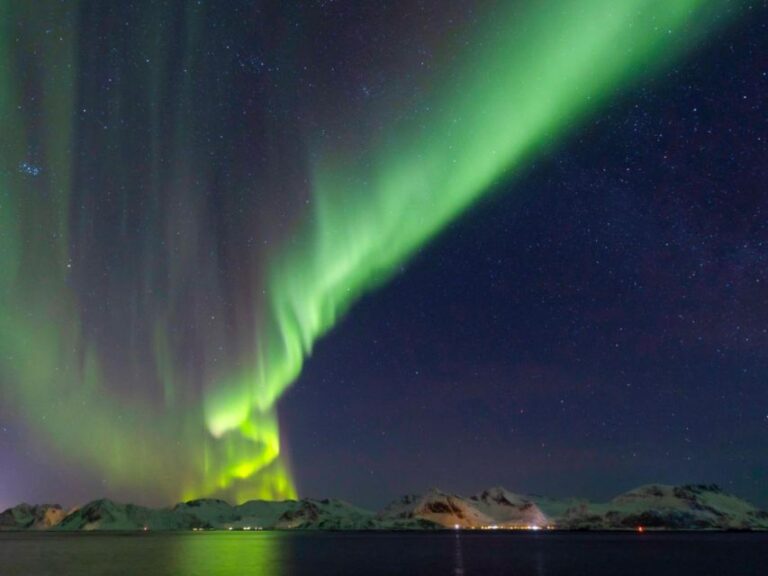What Is Neptune’s Temperature?
Have you ever looked up into the night sky and wondered what mysteries are hidden beyond our atmosphere? What lies in the depths of outer space, outside of our solar system? One such mystery is Neptune, one of the gas giants that orbits around our sun. But how hot does it get on Neptune? In this article we will uncover some of its secrets to help answer this question and explore more about what makes up our solar system.
The Discovery of Neptune
The Birth of a New Planet
The year was 1846 when astronomers, who had been studying the planet Uranus for quite some time, noticed something strange. Though they had expected it to move in a predictable pattern through its orbit around the sun, it instead seemed to be deviating from their calculations. After much deliberation and debate, two scientists – John Couch Adams and Urbain Le Verrier – independently came up with the same conclusion: that an additional object must be present in our solar system influencing Uranus’s motion. As luck would have it, this prediction proved true and on September 23rd of 1846 Neptune was discovered by Johann Gottfried Galle at Berlin Observatory.
A Revolutionary Idea
Up until that point, most people only believed that what we could see with our eyes made up all there was in space – namely those seven planets which were visible without any special equipment. But Adams and Le Verrier’s discovery shattered this belief; not only did they manage to predict Neptune’s existence but also its position within the heavens as well! This revolutionary idea would pave the way for further advancements in astronomy such as Albert Einstein’s Theory of Relativity more than half a century later which gave us an even deeper understanding of gravity throughout our universe..
An Unprecedented Accomplishment
It is hard for us today to appreciate just how momentous Adams’ and Le Verriers’ achievement really was or how difficult predicting Neptune’s existence actually was given the technology available at that time period (calculators weren’t invented until 60 years later). With no computers or telescopes powerful enough to detect details about distant stars or planets like we can today, these two brilliant minds used mathematics alone based on careful observations taken over many decades to come up with their groundbreaking conclusions about Neptune’s location – truly an unprecedented accomplishment!
Atmosphere and Composition of Neptune
Neptune is the eighth and furthest planet from our Sun, having been discovered in 1846. It has a strong nitrogen-dominated atmosphere composed of 80% hydrogen, 19% helium and 1.5% methane gas. Its atmospheric pressure at its surface is 7 times stronger than Earth’s, which makes it one of the most turbulent planets in the Solar System.
Temperature:
The average temperature on Neptune is -214°C (-353°F), making it an icy world with little to no liquid water on its surface. In fact, temperatures can drop as low as 55 Kelvin (-218 °C; -361 °F). However, due to internal heat sources generated by radioactive decay or tidal heating caused by its moons’ gravitational pull, some areas like the north pole may be warmer than expected for such a cold planet.
Clouds:
Besides being an extremely windy place — winds reach speeds up to 2000 km/h (1125 mph) — Neptune also has visible clouds that form different patterns across its sky.
- At high altitudes there are white cirrus clouds made of frozen methane.
- These are followed by wispy mid-level stratocumulus clouds made out of ammonia ice.
- At lower levels they become thicker cumulonimbus clouds composed mainly of water ice particles.
. The fast rotation rate causes storms that create bright spots known as ‘Great Dark Spots’ similar but larger than Jupiter’s Great Red Spot. These dark spots typically last for several years before dissipating and then reappearing again elsewhere on Neptune’s disc.
Other Components: < br >Apart from gases like hydrogen and helium , other trace elements can be found inside Neptune’s atmosphere . These include hydrocarbons , carbon monoxide , CO2 , sulfur compounds ( SO3 ) , phosphine and ethane . Also present are various dust particles like iron sulfide droplets or soot produced by lightning strikes . Some scientists think these could have contributed to creating heavy rains containing hydrocarbon compounds over time .
Temperature on Neptune’s Surface
The temperature of Neptune’s surface is significantly colder than Earth. While the average temperature on Earth is around 57 degrees Fahrenheit (14 degrees Celsius), the average temperature on Neptune’s surface hovers at -353 degrees Fahrenheit (-214 degrees Celsius). This immense difference makes it impossible for human life to exist on this planet, as temperatures this cold are inhospitable to most forms of known organic life.
This extreme cold can be attributed to a few different factors. First and foremost, Neptune orbits much farther away from the sun than our own planet does; its distance ranges between 2.8 and 4.5 billion miles depending on where it is in its orbit cycle. This means that sunlight has less time to reach Neptune’s atmosphere before being reflected back into space compared with how quickly it reaches Earth’s atmosphere—making it harder for warmth from sunlight to permeate all the way through Neptune’s clouds and down onto its frigid landscape.
Plus, despite being an ice giant comprised mostly of gas, Neptunes dense atmosphere allows some heat energy generated by natural processes within the planet itself — such as core convection —to stay trapped inside like a blanket, further contributing towards keeping temperatures low across its entire surface area.. It should be noted that while these same atmospheric dynamics keep temperatures low almost everywhere throughout the entirety of Neptune’a globe they do not always remain consistent – localized areas near certain cloud formations may occasionally experience higher levels of warmth due to their proximity to solar radiation or other influences .
Great Dark Spot on Neptune
The Great Dark Spot on Neptune is a phenomenon that has fascinated astronomers for years. It was first discovered in 1989 by the Voyager 2 spacecraft as it sailed passed the planet, and since then its mysterious origins have been debated over.
The spot itself appears to be an anti-cyclonic storm system, similar to that seen in Earth’s hurricane systems. Its size has been measured at 13000 km across which makes it roughly the same size as our entire planet! The exact cause of this giant dark area is still unknown but scientists believe that it could be related to high altitude clouds made up from methane ice crystals or perhaps even something more mysterious like air being forced out from deep within Neptune’s atmosphere.
A few years after its discovery the spot had disappeared completely and some theories suggest that this may have been due to seasonal changes in the atmosphere of Neptune or perhaps even due to a shift in winds blowing across its surface. Despite all of these theories, nobody can really say exactly what caused this dark patch on one of our outer planets – making it an intriguing mystery indeed!
Moons Around Neptune
Neptune, the eighth planet from the sun and farthest known planet in our solar system, has an impressive set of moons orbiting it. The first of these moons to be discovered was Triton by William Lassell just seventeen days after Neptune itself was found. Since then, 14 more moons have been identified in Neptune’s orbit, with some having diameter measurements exceeding 200 kilometers.
Triton is a very interesting moon due to its complex geological features and cryovolcanism activity as well as being one of few objects in space that orbits its host body retrogradely (opposite direction). It has also become known as one of the most extreme places in our Solar System due to its surface temperature which can range between -235°C and -210°C depending on location and time. Therefore it is no surprise that this remarkable world has drawn much attention for exploration missions such as Voyager 2 – launched by NASA back in August 1989 which became the only spacecraft ever to visit this distant moon when it flew past four years later.
The other 13 satellites around Neptune are: Naiad, Thalassa , Despina , Galatea , Larissa , Proteus , Halimede , Psamathe , Sao, Laomedeia, Neso & Hippocamp . All of these bodies share some common characteristics such as dark surfaces composed mainly from water ice indicating they were formed beyond a certain distance away from he Sun where temperatures are low enough for ice particles to remain stable over long periods of time.
All together these 15 moons offer us a great opportunity to understand better how planets form and evolve over time while allowing scientists valuable insight into what conditions might exist on extraterrestrial worlds within our own Solar System or even elsewhere throughout the Universe
Exploration Missions to Neptune
Exploring the Gas Giant
The mysterious planet Neptune has been a source of fascination for astronomers and scientists since its discovery in 1846. One of the furthest planets from our Sun, it is also one of the most captivating; with unknown features such as clouds that can reach thousands of kilometers wide and winds that exceed 1,000 miles per hour, there’s no shortage of mysteries to explore. As technology advances, humanity has taken steps towards understanding this distant world by launching exploration missions to investigate Neptune and its moons.
The first spacecraft sent out on an exploration mission was Voyager 2 in 1989. It passed within 4,950 kilometers of Neptune’s cloud tops and obtained detailed images which revealed features never seen before such as high-altitude clouds spanning thousands of kilometers across the planet’s upper atmosphere. This data provided insight into how these winds interact with each other as well as information about atmospheric temperatures and pressures present near the surface. The mission even gave us a better idea concerning size estimates for some smaller moons orbiting close to Neptune including Nereid and Proteus.
In 2004 NASA launched another robotic space probe called New Horizons, which flew past Pluto in 2015 before moving on to continue exploring further out into space including around Uranus then finally coming back around to study both Triton -the largest moon orbiting Neptune-and Nereid again more closely than ever before possible using modern day equipment.
- It uncovered evidence suggesting a subsurface ocean beneath Triton’s icy crust.
- Data gathered suggests dark material may be coating part or all its surface.
. Particles left behind from comets colliding with this moon were discovered during flyby making up fine dust particles floating along just above it’s outermost layer creating an ethereal effect when looking down upon it from above through telescope lenses.
These explorations have given us unprecedented access not only into the secrets surrounding these two worlds but human knowledge itself expands every time we gain new insights like these allowing us to paint clearer pictures concerning what lies beyond our Solar System while simultaneously prompting us all ask bigger questions about where else might life exist out there amongst those stars?
Potential for Habitability On or Near the Planet
Mars
The Red Planet – An Overview
Mars has long fascinated astronomers and astrobiologists alike due to its resemblance with Earth. It is the fourth planet from the Sun, and it has a day-night cycle similar to ours. Plus, Mars has seasons like we do here on Earth, as well as clouds, wind storms and polar ice caps. Scientists have recently discovered evidence of ancient flowing water on Mars’ surface which opens up exciting possibilities for life beyond our own planet.
Potential for Habitability
At present there is no hard evidence that suggests any form of life exists on or near the planet Mars; however, scientists continue searching for clues in order to answer this age-old question. Recent studies suggest that conditions may be suitable enough to sustain some forms of microbial life beneath its soil or inside liquid pools under subsurface Martian glaciers.
Exploration & Colonization
In recent years numerous robotic missions have been sent by various space agencies such as NASA and ESA in an effort to explore the red planet more closely. These probes are designed to collect data regarding potential habitability related factors such as atmospheric composition, geology and climate conditions among many others; all hoping that one day humans could make their home on this distant world. To prepare for future human exploration several test habitats have already been established around the world where people are living under simulated Martian conditions in order to understand how best we can establish a sustainable outpost on Mars someday soon!





